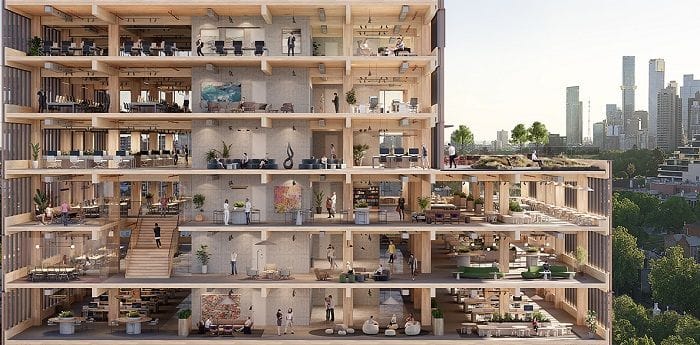A development led by global real estate group Hines that is set to become one of Melbourne's tallest hybrid mass timber buildings has received support from the Clean Energy Finance Corporation (CEFC), joining other backers including the Madigan Active Debt Fund and the Victorian Funds Management Corporation.
Hines acquired the 2,120sqm site on 36 Wellington St Collingwood in 2019 and plans to develop a 15-storey prime-grade office tower with the principles of its T3 (Timber, Transit and Technology) strategy, which aims to replace traditional structural systems such as concrete and steel.
The developer estimates the project will deliver a dual emissions reduction impact – cutting embodied carbon levels by as much as 40 per cent during the construction phase, before targeting net zero emissions once operational. The timber will be sourced from XLam Australia and Australian Sustainable Hardwoods.
The CEFC has committed up to $70 million in debt financing for T3 Collingwood - the first to be financed under the CEFC Timber Building Program that has received an initial $300 million allocation.
"We are very pleased to announce T3 Collingwood as our first investment under the innovative CEFC Timber Building Program, which aims to encourage the use of mass timber in the construction sector," CEFC CEO Ian Learmonth said.
"Mass timber can play an important role in decarbonising the buildings that make up our cities and this investment showcases how timber can be used to change the way we approach commercial scale buildings.
"Timber has a vital role to play in addressing embodied carbon and represents the next frontier for the property industry."
Learmonth said the commercial property sector had been making significant progress to reduce operational carbon.
"This project encourages owners, developers, architects, engineers and builders to use mass timber as an alternative to conventional construction materials such as concrete and steel for their projects," he said.

Including biogenic carbon storage, embodied carbon emitted during construction – in processes such as raw material procurement, manufacturing, construction and demolition – is equal to an emissions reduction of approximately 40 per cent compared with the equivalent use of reinforced concrete.
The hybrid construction approach will feature a glue laminated timber (GLT) structure with cross-laminated timber (CLT) flooring on top of five reinforced concrete podium levels.
"Mass-timber construction is an important step in driving a sustainable future for the built environment we live and work in," Hines Australia managing director Simon Nasa said.
"Not only is timber a completely renewable resource, but timber offices are also biophilic in creating a more natural working environment for tenants and their staff.
"This results in increased productivity and better mental health outcomes, helping to create the people-friendly live-work-play communities that Hines is known for."
Madigan Capital founder and CEO Michael Wood said the use of leading environmentally sustainable construction techniques strongly aligned with his company's investment strategy.
"As one of Australia’s leading institutional non-bank lenders in the real estate market, we believe we have a responsibility to invest in projects that are working towards using sustainably sourced construction methods and materials to reduce operational and embodied carbon," Wood said.
CEFC joint head of property Ryan Rathborne said the time was right for development of more timber buildings across the property sector.
"By locking in mass timber construction in new projects, we can also help develop local skills and experience, supply chains and delivery capabilities, all of which can catalyse more timber-based building activity into the future," Rathborne said.
"T3 Collingwood is an exciting project that signals the very real potential to create a greener, more sustainable built environment. It demonstrates the critical role of timber in the construction phase, and how this can complement ongoing commitments to net zero emissions in operations.
"This project is also a great vote of confidence in a new sustainable timber industry for Australia. We are encouraged that Hines will be working with Australian businesses to supply aspects of the build, delivering positive impacts for domestic industries and supply chains."

Get our daily business news
Sign up to our free email news updates.

)
)

)
)
)
)

